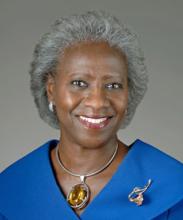

DR. VALANTINE'S FOOD FOR THOUGHT
Hannah A. Valantine, MD Chief Officer for Scientific Workforce Diversity
Many factors contribute to a child’s answer to the question “What do you want to be when you grow up?” As you’ll see in this newsletter, a very diverse set of factors affect an individual’s choice to choose science. Those factors, in turn, help to build a knowledge base in biomedicine that reflects the broad interests and challenges of our society. But success in science comes not only from individual effort. Systemic support for diversity and inclusion – also visited below – is vital.
Why I Became a Scientist
How does identity contribute to what a scientist chooses to study? In this interesting collection of brief interviews, researchers from across the world share their unique backgrounds and how those experiences shaped them and their science. Influences are many, ranging from a drive to help their communities, overcome obstacles, embrace multidisciplinary work, answer questions raised by their families and childhood, as well as approach research with a spirit of inclusion.
Honoring Women in Science: Paying Tribute to Paul Greengard
A few weeks ago, renowned neuroscientist Paul Greengard died at the age of 93. The Nobel laureate shared his prize with Eric Kandel and Arvid Carlsson for their work showing that brain communication involves both electrical and chemical signaling. One of Greengard’s greatest legacies for science, however, was his unwavering dedication to advancing women in sciencer: He used his Nobel prize money to establish an award to recognize women doing outstanding biomedical research. Greengard named the prize after his mother, who died giving birth to him.
Taking a Stand Against Sexual Harassment
The landmark National Academies Report on Preventing Sexual Harassment documented that sexual harassment, in particular gender harassment, is unfortunately alive and well in biomedicine and offered several recommendations to stop it. These include many efforts currently underway at NIH such as fostering diverse, inclusive, and respectful environments; attaining strong and diverse leadership; and offering numerous resources to individuals experiencing harassment. Professional societies have a critical role to play, too, and now 77 organizations have joined together to form the Societies Consortium on Sexual Harassment in STEMM. The group will start by developing research- and evidence-based resources for societies that include findings and expertise from the social and behavioral sciences.
What Does it Take to Get an NIH Grant?
A key goal of the NIH-funded National Research Mentoring Network (NRMN) is to help early-career scientists from underrepresented groups (URGs) acquire NIH research funding. Recently, NRMN researchers analyzed the grant submissions from 880 investigators (comparing those from URG and well-represented groups) who sent in online applications to join an NRMN grant-coaching program. They identified several intervention points that would likely boost the chances for URGs to obtain an NIH grant.

The links above are pulled from the top news articles trending on the subject of diversity in science and technology.
The stories selected are not a reflection of the views of the National Institutes of Health.

